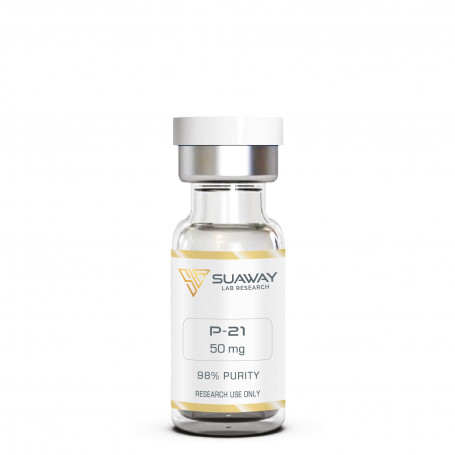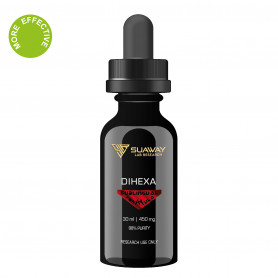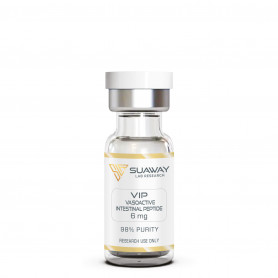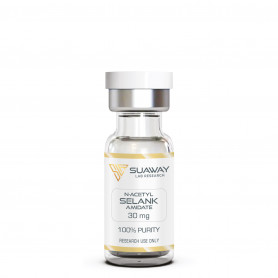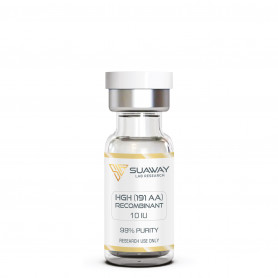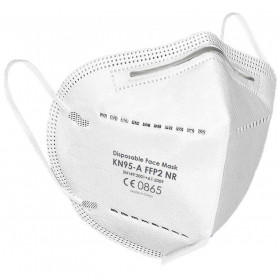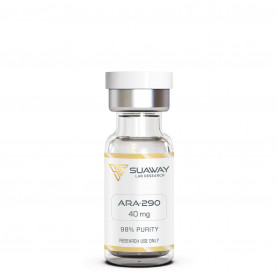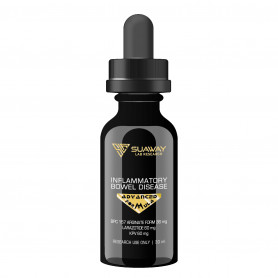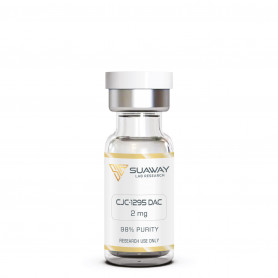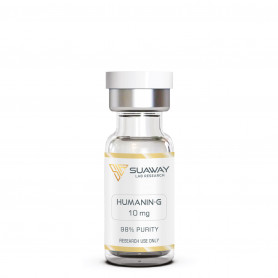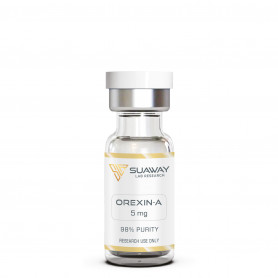P-21 - 50 mg
Research shows that P21 raises levels of BDNF (brain-derived neurotrophic factor), which promotes neurogenesis (a nerve growth) and stops the formation of Amyloid plaques and Tau proteins, which are signs of Alzheimer's disease.
BDNF has been related to increased neurogenesis as well as the downregulation of an enzyme that forms tau and amyloid plaques in Alzheimer's disease brains.
Various research proves that P21 enhances learning and cognition.
Description
STRUCTURE
Sequence: Ac-DGGL-adamantane-G-NH2
Molecular Formula: C30H54N6O5
Molecular Weight: 578.3 g/mol
Peptide purity: Greater than 98%
Other details: No TFA Salt
Storage: Lyophilized peptide must be stored at -20°C and peptide solution at 4°C.
P21 has good oral and excellent subcutaneous bioavailability.
Note: P-21 comprises an adamantyl group at the C- and/or N-terminal end. Design and structures of neurogenic peptidergic compounds incorporating adamantane building blocks. From the neurogenic undecamer Ac-VGDGGLFEKKL-NH2 (Peptide 6) a truncated, still neurogenic tetramer Ac-DGGL-NH2 (Peptide 6c) was designed. Addition of an unnatural amino acid based upon adamantane to the C-terminus of this subsequence via solid phase peptide synthesis methods produced Ac-DGGLAG-NH2 (P21).
DESCRITPION
A short peptide variant of CNTF is P21. In humans, CNTF is a naturally occurring protein that mediates neuron development.
Epitope mapping, a technique that makes use of antibodies to pinpoint target binding sites, is how P21 was created. In the instance of P21, the CNTF binding site was first located using antibodies against CNTF receptor active sites. The short, synthetic peptides were then employed to establish which ones hampered antibody binding by imitating CNTF binding. P21, which not only binds to the CNTF receptor but also penetrates the blood-brain barrier, was produced as a consequence. The C-terminal end was modified with admantylated glycine to improve blood-brain barrier permeability & decrease exopeptidase degradation.
Natural CNTF is too big to pass across the blood-brain barrier, has poor plasma stability, an undesirable pharmacologic profile, and when given systemically, actually encourages the production of anti-CNTF antibodies.
In contrast to pure CNTF, P21 has better than 95% stability in synthetic gastric juice over 30 minutes, which is sufficient time for it to typically transit through the stomach. For two hours, it is about 100% stable in the gut, which is sufficient time for absorption. In blood plasma, it remains stable for almost three hours.
The principal influence of P21 on the central nervous system is the development of neurogenesis or neuron maturation in the granular cell layer or sub-granular zone. P21 has other effects as well.
It is believed that the dentate gyrus, a portion of the hippocampus formation in the temporal lobe of the brain, aids in the creation of fresh episodic memories as well as spontaneous exploration and learning in novel surroundings.
Even though P21 is referred to as a mimetic, it should be obvious that it is not an analog of CNTF, according to research in mice models, which demonstrates that it does not attach to the CNTF receptor. Instead, it seems as if P21 works to stop antibodies or other molecules from neutralizing CNTF.
P21's suppression of LIF-STAT signaling seems to be the source of another aspect of its action. Similar to interleukin 6, LIF is a cytokine that is crucial during development. It is in charge of preventing differentiation, which controls cell proliferation in a manner that may be beneficial for accelerating tissue maturation even if it results in a reduction in proliferation. A barrier to neurogenesis is removed by P21's inhibition of LIF, putting the brain in a more embryologic condition where neuron development is encouraged.
The dentate gyrus in Alzheimer's disease (AD) becomes more active as a result of the brain's normal reaction to injury, which includes the loss of neurons and synapses. Unfortunately, a lot of old brains do not sustain neurogenesis, therefore the attempt at replacement fails. P21 sufficiently increases dentate gyrus activity to get beyond this restriction, which helps tip the scales in favor of neurogenesis and away from neurotrophic factors. So it is possible that preventing the buildup of amyloid in the brain is not the sole strategy to combat AD's consequences. This may help to explain why, although plaque deposition starts early in AD, its consequences are not seen until later in life, when the balance of neurotrophic factors moves away from neurogenesis. According to studies, P21's neurotrophic support increases brain-derived neurotrophic factor & neurotrophin-4 levels while reducing the mitogenic effects of fibroblast growth factor 2 and the other neurotrophic factors. It is interesting to note that administering P21 before the beginning of AD avoids the cognitive deterioration that often happens in mice models of the disease. As a result, it could be even more crucial to use P21 as a prophylactic measure than as a possible therapy.
It is also critical to remember that BDNF has been related not just to improved neurogenesis but also to the suppression of a specific enzyme that creates tau and amyloid plaques in AD brains. In particular, BDNF reduces the activity of the GSK3-beta protein, which catalyzes both the phosphorylation of tau protein and the production of amyloid beta from an amyloid precursor protein, two stages in the progression of AD that result in inflammation and eventually neurodegeneration.
It is important to note that GSK-3beta overproduction has been connected to the development of various diseases, including type 2 diabetes, a variety of cancers, and bipolar disorder. There is optimism that P21 and other GSK-3beta inhibitors may be successful in treating bipolar illness, cancer, and stroke.
In particular, P21 seems to halt the decline in MAP2 expression that has been seen in AD-affected brains. A measure of synapse development between neurons is MAP2 (microtubule-associated protein 2). This protein's level is a sign of AD disease progression and suggests that synaptogenesis and neurogenesis have diminished. P21 is also seen to reverse reductions in:
• Synapsin I, an essential protein for neural synaptic connection.
• GluR1, a receptor that facilitates rapid synaptic transmission (AMPA receptor).
• NR1, a glutamate receptor linked to learning and synaptic plasticity.
The ability of P21 to increase the levels of synapsin I, GluR1, and NR1 in both healthy and sick brains is perhaps what is most intriguing about its actions on these molecules. Researchers have concluded that P21 may also help enhance function in healthy brains, in addition to restoring function in damaged brains. As a result, it could be effective as a nootropic and performance booster for mental work. Animal models for this research have not yet been used, many alone human trials. P21 increases levels of neurogenesis in sick brains above those reported in healthy, untreated brains, demonstrating how powerful it is in promoting this process.
The optimal moment to provide P21, at least in the context of sickness, is when it can strengthen and support the body's natural reaction to neuronal loss. P21 may be the first serious opportunity neuroscience has had to delay or perhaps arrest the process of neurodegeneration when combined with early diagnosis by clinical indicators. He says that an imbalance between neuron death and neurogenesis is the issue with AD, at least early on in the course of the disorder. P21 tips the scales in favor of neurogenesis and, at least in the few animal experiments that have been done, enhances damaged brains even further than the neurogenesis found in healthy brains. P21, in other words, overcomes impairments in neurogenesis to enhance neuroplasticity, a function that is evident not just histologically but also in clinical tests of cognition, memory, and reasoning.
P21 improves cognition and shields the central nervous system from harm, to put it simply. It seems to do this by accelerating the transition of neurons from precursor cells to mature neurons. Additionally, it seems to promote synaptogenesis—the process by which neurons connect—which is crucial for memory consolidation and learning.
More specifically, the molecule provides a variety of advantages for memory, cognition, and learning. It has been shown, for instance, to increase levels of brain-derived neurotrophic factor and neurotrophin-4 in mice models. Synapsin 1, GluR1, and NR1 levels are all indicators of neurogenesis and synapse formation, and it has been shown in animal studies that all three proteins are increased. It is interesting that although it increases these proteins' levels in sickness, it increases them to supraphysiologic levels in health, indicating that P21 may support learning and memory even in brains that are in good condition.
Cerebrolysin seems to have significant effects on the dentate gyrus, similar to P21. Cerebrolysin has been shown to enhance cognitive function and synaptic plasticity in Alzheimer's disease mice models. Even though the mechanisms behind these advantages are not known, it seems to have neuroprotective effects.
P21 and cerebrallysin are not the same, although this is a common misconception. Cerebrolysin is a peptide mixture with a variety of actions, including neurogenesis, in contrast to P21, which is a single molecule with receptor-specific effects. In experiments on animals, P21 was shown to be more effective than cerebrolysin.
Although they are occasionally used interchangeably in conversations about nootropics, P21 and cerebrallysin are not the same substance. Another name for P21 is "a derivative of cerebrolysin," yet this is likewise not a completely accurate description of P21. P21 is a man-made counterpart of CNTF, which is one of the ingredients in cerebrolysin. Only four CNTF amino acids and an additional adamantane moiety make up P21. So, the easiest way to define P21 is as a synthetic counterpart of one cerebrolysin component. However, P21 is a synthetic molecule and is not present in cerebrolysin. It has been hypothesized that this portion of P21 may be included inside cerebrolysin as a consequence of the breakdown of CNTF.
Because cerebrolysin induces the formation of autoantibodies against CNTF and ultimately becomes useless and even worsens the condition, it has been all but abandoned as a therapy. Cerebrolysin is likely antigenic (raised antibodies) in part because it is a pure porcine product and is thus seen as alien by other species. Cerebrolysin is a pure animal product, thus there is an additional worry that it might be contaminated.
P21 seems to bind to these auto-antibodies and aid in their elimination, increasing the effectiveness of native CNTF and boosting neurogenesis.
REFERENCES
N. Baazaoui et al., "Prevention of dendritic and synaptic deficits and cognitive impairment with a neurotrophic compound" [BMC]
Bin Li et al., "Neurotrophic peptides incorporating adamantane improve learning and memory, promote neurogenesis and synaptic plasticity in mice" [PubMed]
S.F. Kazim et al., "Disease modifying effect of chronic oral treatment with a neurotrophic peptidergic compound in a triple transgenic mouse model of Alzheimer's disease" [PubMed]
S.F. Kazim et al., "Neurotrophic factor small-molecule mimetics mediated neuroregeneration and synaptic repair: emerging therapeutic modality for Alzheimer’s disease" [BMC]
J.J. Luykx et al., "The involvement of GSK3β in bipolar disorder: Integrating evidence from multiple types of genetic studies" [ScienceDirect]
M.K. Mohammad et al., "Olanzapine inhibits glycogen synthase kinase-3beta: an investigation by docking simulation and experimental validation" [PubMed]
K. Iqbal et al., "Shifting balance from neurodegeneration to regeneration of the brain: a novel therapeutic approach to Alzheimer's disease and related neurodegenerative conditions" [PMC]
E. Rockenstein et al., "Effects of Cerebrolysin on neurogenesis in an APP transgenic model of Alzheimer's disease" [PubMed]
H. Chen et al., "Trophic factors counteract elevated FGF-2-induced inhibition of adult neurogenesis" [PubMed]
DISCLAIMER
This product is intendend for lab research and development use only. These studies are performed outside of the body. This product is not medicines or drugs and has not been approved by the FDA or EMA to prevent, treat or cure any medical condition, ailment or disease. Bodily introduction of any kind into humans or animals is strictly forbidden by law. This product should only be handled by licensed, qualified professionals.
All product information provided on this website is for informational and educational purposes only.

